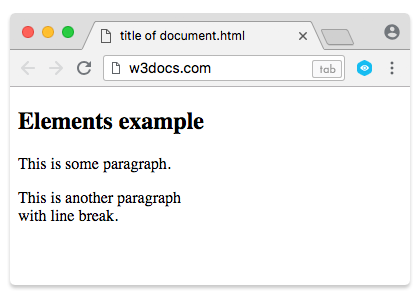The <!DOCTYPE> declaration is the first line of the code in HTML or XHTML document. It specifies the HTML version used in the document. Each HTML document should start with this declaration: so the browsers will render the page compliant with HTML standards. In HTML 4.01, this declaration refers to a Document Type Definition (DTD), which specifies the structure and the legal elements of an XML document.
The <!DOCTYPE> is declared before the <html> tag. The declaration is not case sensitive.
Syntax
[Root element] [Publicity] "[Registration]//[Organization]//[Type] [Name]//[Language]" "[URL]"><!DOCTYPE> Parameters
Root element — a parent element that contains all the other elements. For HTML it is the <html> tag.
Publicity — the document can be PUBLIC or SYSTEM (local files, for example). For HTML/XHTML the value is PUBLIC.
Registration - can have two values: plus (+) - the developer is registered in ISO (International Organization for Standardization) and - (minus) - the developer is not registered. For W3C, the value is set to "-".
Organization — the name of DTD developer. The developer of HTML/XHTML is W3C, and its name is declared in <!DOCTYPE>.
Type — the type of the document. For HTML/XHTML the value is DTD.
Name — unique identifier describing DTD.
Language — the language of the document (two letters in uppercase). For HTML/XHTML the language is English (EN).
URL — the URL of the document type description (e.g. https://www.w3.org/TR/html4/loose.dtd).
Types of the <!DOCTYPE> Declaration for HTML
There are three types of the <!DOCTYPE> declaration for HTML:
Strict - contains all HTML elements and attributes. However, the presentational or deprecated elements are not included.
<!DOCTYPE HTML PUBLIC "-//W3C//DTD HTML 4.01//EN" "https://www.w3.org/TR/html4/strict.dtd">Transitional - contains all HTML elements and attributes, including presentational and deprecated elements. Frames are not allowed.
<!DOCTYPE HTML PUBLIC "-//W3C//DTD HTML 4.01 Transitional//EN" "https://www.w3.org/TR/html4/loose.dtd">Frameset - is equal to Transitional, but allows the use of frames.
<!DOCTYPE HTML PUBLIC "-//W3C//DTD HTML 4.01 Frameset//EN" "https://www.w3.org/TR/html4/frameset.dtd">There is only one version of declaration for HTML 5.
<!DOCTYPE html>Example of the HTML <!DOCTYPE> declaration:
<!DOCTYPE html>
<html>
<head>
<title>Title of the document</title>
</head>
<body>
<h2>Elements example</h2>
<p>This is some paragraph.</p>
<p>This is another paragraph <br/> with line break.</p>
</body>
</html>Result

Types of the <!DOCTYPE> Declaration for XHTML
Here you can find types of the <!DOCTYPE> declaration for XHTML.
XHTML 1.0 Strict
This DTD includes all the HTML elements and attributes, except presentational or deprecated elements. This DTD doesn’t allow frameworks.
<!DOCTYPE html PUBLIC "-//W3C//DTD XHTML 1.0 Strict//EN" "http://www.w3.org/TR/xhtml1/DTD/xhtml1-strict.dtd">XHTML 1.0 Transitional
This DTD includes all the HTML elements and attributes, as well as presentational and deprecated elements. Framesets are not allowed.
<!DOCTYPE html PUBLIC "-//W3C//DTD XHTML 1.0 Transitional//EN" "http://www.w3.org/TR/xhtml1/DTD/xhtml1-transitional.dtd">XHTML 1.0 Frameset
This DTD is similar to XHTML 1.0 Transitional, but framesets are allowed.
<!DOCTYPE html PUBLIC "-//W3C//DTD XHTML 1.0 Frameset//EN" "http://www.w3.org/TR/xhtml1/DTD/xhtml1-frameset.dtd">XHTML 1.1
This DTD is equal to XHTML 1.0 Strict, but allows adding modules (e.g., to provide Ruby support for East-Asian languages).
<!DOCTYPE html PUBLIC "-//W3C//DTD XHTML 1.1//EN" "http://www.w3.org/TR/xhtml11/DTD/xhtml11.dtd">Browser support
|
|
|
|
|
|
|---|---|---|---|---|
| ✓ | ✓ | ✓ | ✓ | ✓ |
Practice Your Knowledge
Quiz Time: Test Your Skills!
Ready to challenge what you've learned? Dive into our interactive quizzes for a deeper understanding and a fun way to reinforce your knowledge.